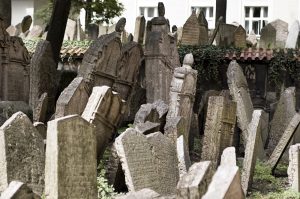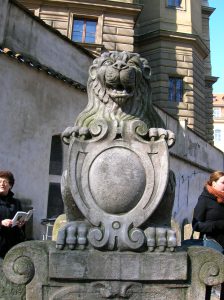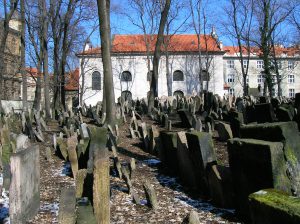The Old Jewish Cemetery in Prague’s Jewish Town
By Tracy A. Burns
Each tombstone tells a story
 Each crooked tombstone in the third oldest Jewish cemetery in Europe tells a story, crying out its own eerie song. There are stories of pogroms, fires, and floods. Lavish tombstones speak of the golden days in the 16th century Renaissance when Emperor Rudolph II ruled. And do not forget the tales about the Jews defending Prague against the Swedes in 1648, during the Thirty Years’ War. Yes, there are many stories that these 12,000 tombstones have to tell.
Each crooked tombstone in the third oldest Jewish cemetery in Europe tells a story, crying out its own eerie song. There are stories of pogroms, fires, and floods. Lavish tombstones speak of the golden days in the 16th century Renaissance when Emperor Rudolph II ruled. And do not forget the tales about the Jews defending Prague against the Swedes in 1648, during the Thirty Years’ War. Yes, there are many stories that these 12,000 tombstones have to tell.
How old is the Old Jewish Cemetery?
The Old Jewish Cemetery is located among streets U stareho hrbitova, Brehova, Siroka, and 17. Listopadu, was the only burial place for Prague Jews from 1439 to 1787. Prague Jews were not allowed to be buried outside the ghetto, and the Jewish faith does not permit moving the dead, so the deceased were buried in as many as 12 layers. Some 100,000 Jews are interred in this cemetery that inspired so many works of art and literature by leading writers and artists. The earliest tombstone, that of rabbi Avigdor Kara, dates from 1439, and the first documented existence of the holy place goes back to 1438.
From 16th century expansion to 19th-century redevelopment
The last person to call this cemetery home was Moses Beck, who was put to rest in 1787, shortly before Emperor Joseph II forbid people from burying the dead inside the city walls for sanitary reasons. While the cemetery was expanded in the late 16th century and late 17th century, during the clearance of the Jewish Town at the end of the 19th century, it was reduced in size to make way for the Museum of Applied Arts. Remains were moved to the New Jewish Cemetery in Zizkov, the nearby Klausen Synagogue or other places.
The style of the tombstones
 The style of the tombstones was inspired by Jewish tombs in the Roman catacombs and Gothic tombstones in Jewish cemeteries in France, Austria, and other places. The 16th and 17th-century ornate tombstones feature sculptural symbols symbolizing the person’s family name or profession, for instance. A bunch of grapes stands for fertility and wisdom while musical instruments and animals also decorated the tombstones. The symbols for professions include scissors denoting a tailor and a quill referring to a writer. The depiction of books on a shelf signifies a rabbi. There are also images of human figures on the tombstones, which is something rare. During the Renaissance times, poetry and biblical quotes often served as inscriptions. Twenty of the tombs from the 16th century have four sides crowned with a gable and saddle roof. These were reserved for the most prominent Jews.
The style of the tombstones was inspired by Jewish tombs in the Roman catacombs and Gothic tombstones in Jewish cemeteries in France, Austria, and other places. The 16th and 17th-century ornate tombstones feature sculptural symbols symbolizing the person’s family name or profession, for instance. A bunch of grapes stands for fertility and wisdom while musical instruments and animals also decorated the tombstones. The symbols for professions include scissors denoting a tailor and a quill referring to a writer. The depiction of books on a shelf signifies a rabbi. There are also images of human figures on the tombstones, which is something rare. During the Renaissance times, poetry and biblical quotes often served as inscriptions. Twenty of the tombs from the 16th century have four sides crowned with a gable and saddle roof. These were reserved for the most prominent Jews.
The use of Czech and Hebrew
Because Czech was spoken in the ghetto, some inscriptions were in Czech, but epitaphs were written in Hebrew. Since people did not use last names before the 16th century, many of the deceased are named after the district where they had resided. The number of original epitaphs totals about 8,000.
Famous Jews buried in the cemetery
Some famous Jews who are buried here in addition to the rabbi and scholar Avigdor Kara include Mordechai ben Samuel Maisel, an entrepreneur and former 16th-century Jewish Town mayor who had his own private synagogue built. Rabbi Jehuda Loew, who lived during the 16th century and is said to have created the artificial, clay creature called the Golem, is buried in a four-sided tomb as is Maisel. Thirty-three of the rabbi’s students are interred in close proximity to him, as they desired to be buried near their beloved teacher. David Gans, who scribed the first modern work about Jews, was laid to rest here as well. The only tombstone for a woman was created for Hendl Basevi, the wife of a wealthy businessman who was also one of the Jewish Town’s former mayors.
Practical information
 Sometimes visitors leave pebbles or prayers written on small pieces of paper on the tombstones. It is entered from the Pinkas Synagogue, which serves as a memorial to the victims of the Holocaust. The admission fee is 300 Czech crowns for the cemetery as well as four synagogues. It costs an extra 40 crowns for permission to take photos. The cemetery is closed on Saturdays and Jewish holidays but otherwise open from April through October from 9 am to 6 pm and from November to March from 9 am to 4:30 pm.
Sometimes visitors leave pebbles or prayers written on small pieces of paper on the tombstones. It is entered from the Pinkas Synagogue, which serves as a memorial to the victims of the Holocaust. The admission fee is 300 Czech crowns for the cemetery as well as four synagogues. It costs an extra 40 crowns for permission to take photos. The cemetery is closed on Saturdays and Jewish holidays but otherwise open from April through October from 9 am to 6 pm and from November to March from 9 am to 4:30 pm.



